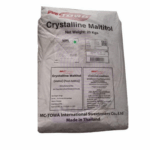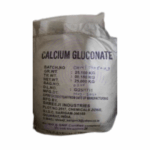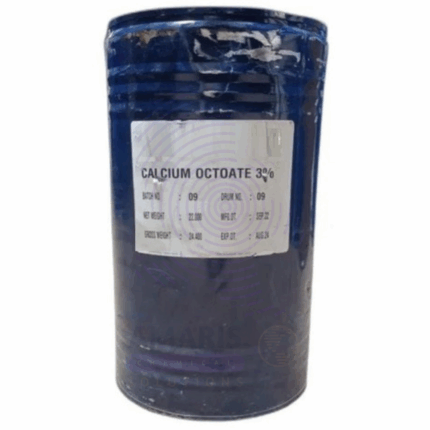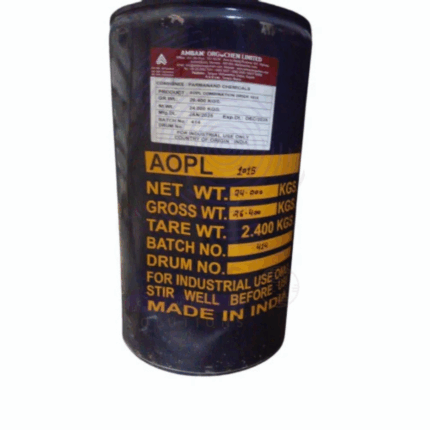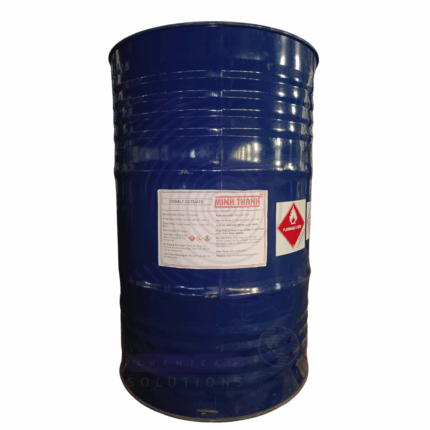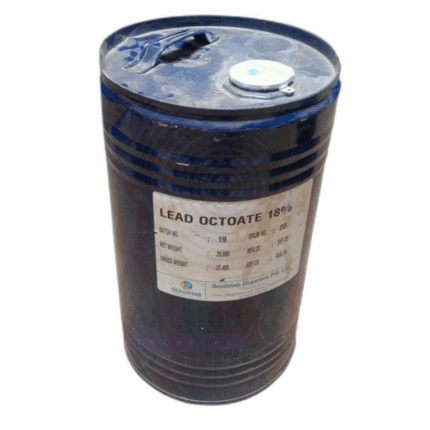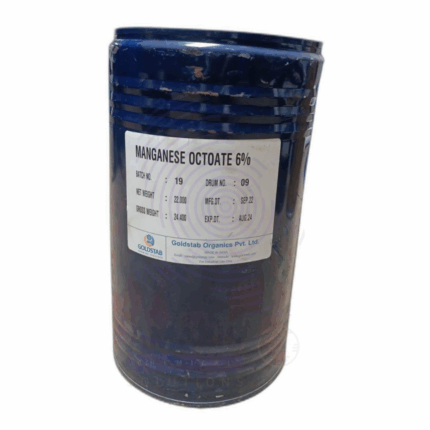Calcium Drier
Calcium Drier is a metal-based drying agent primarily composed of calcium salts of fatty acids (commonly calcium octoate or calcium linoleate), widely used as a siccative in paints, varnishes, inks, and coatings. It functions as a catalyst to accelerate the oxidative cross-linking and polymerization of drying oils, leading to faster drying times and improved film hardness and durability. Calcium Driers are valued for their good compatibility with other driers, low toxicity, and efficient catalytic activity at low concentrations. They are commonly used alone or in combination with other metal driers such as cobalt or manganese driers for optimized drying performance.
Calcium Drier
Primary Uses
- Paints & Coatings
- Used as a siccative agent in alkyd resin-based paints, varnishes, and enamels to speed up drying and curing.
- Enhances film formation, hardness, and gloss of the final coating.
- Works synergistically with other metallic driers like cobalt and manganese to optimize drying kinetics.
- Printing Inks
- Applied in oil-based and alkyd printing inks to improve drying rates and reduce tackiness.
- Facilitates better adhesion and faster handling in printing processes.
- Wood Finishes & Stains
- Incorporated in wood varnishes and stains to promote faster drying and durable finishes.
Secondary Uses
- Industrial Applications
- Utilized in manufacturing of certain adhesives and sealants where drying oils are components.
- Used in automotive and marine coatings for improved curing.
- Art Supplies
- Added to artist oil paints to accelerate drying without affecting color quality.
1. Basic Identification Attributes
- Chemical Name (IUPAC): Calcium octanoate (typical) or calcium salts of fatty acids
- Common/Trade Name: Calcium Drier, Calcium Octoate Drier, Calcium Drying Agent
- CAS Number: Variable, e.g., Calcium octanoate (1592-23-0)
- HS Code: 3811.90.00
- Molecular Formula: Dependent on fatty acid, e.g., C16H30CaO4 (Calcium octanoate)
- Synonyms:
- Calcium Octoate
- Calcium Fatty Acid Salt
- Calcium Drying Agent
- Calcium-based Siccative
2. Physical & Chemical Properties
- Physical State: Viscous liquid or solid (depending on specific formulation)
- Color & Odor: Pale yellow to amber; mild fatty odor
- Melting Point: Typically 140–150°C (for solid forms)
- Boiling Point: Decomposes before boiling
- Density: Approx. 1.0–1.2 g/cm³ (liquid form)
- Solubility: Insoluble in water; soluble in organic solvents and oils
- pH: Neutral to slightly alkaline
- Stability: Stable under normal storage; sensitive to moisture
3. Safety & Hazard Attributes
- Hazard Class (GHS): Not classified as hazardous; mild irritant potential
- NFPA Ratings:
- Health: 1
- Flammability: 1
- Reactivity: 0
- Exposure Limits: No specific OSHA/ACGIH limits; avoid inhalation of aerosols or dust
- Toxicity: Low acute toxicity; may cause mild skin or eye irritation
- Reactivity: Stable; avoid strong acids and oxidizers
4. Storage & Handling Attributes
- Storage Conditions: Store in a cool, dry, well-ventilated area away from moisture and heat
- Container Type: Sealed metal or plastic drums or containers resistant to fatty acids
- Shelf Life: Typically 1–3 years under proper storage conditions
- Special Handling: Use PPE to avoid skin and eye contact; prevent inhalation of mist or dust
5. Regulatory & Compliance Attributes
- FDA Status: Not applicable (industrial chemical)
- Transportation: Not classified as hazardous for transport
- Waste Disposal: Dispose in accordance with local environmental regulations
6. Environmental & Health Impact
- Ecotoxicity: Low environmental hazard but avoid release to waterways
- Persistence: Biodegradable under aerobic conditions
- Bioaccumulation: Not expected to bioaccumulate
- Carcinogenicity/Mutagenicity: Not classified as carcinogenic or mutagenic
- Biodegradability: Readily biodegradable
Safety Handling Precautions
Personal Protective Equipment (PPE):
- Gloves
- Safety goggles
- Protective clothing
Handling Measures:
- Avoid skin and eye contact
- Prevent inhalation of vapors or mist
- Work in well-ventilated area
Storage Measures:
- Keep containers tightly closed
- Protect from moisture and heat
Hygiene Practices:
- Wash hands after handling
- Do not eat, drink, or smoke when handling
First Aid Measures
- Inhalation: Move to fresh air; seek medical attention if respiratory irritation occurs
- Skin Contact: Wash with soap and water; seek medical advice if irritation develops
- Eye Contact: Rinse with plenty of water for at least 15 minutes; seek medical advice if irritation persists
- Ingestion: Rinse mouth; seek medical attention if large quantities ingested
Firefighting Measures
- Fire Hazards: Combustible; emits toxic fumes when burned
- Extinguishing Media: Use foam, dry chemical, CO₂, or water spray
- Special Precautions: Firefighters should wear full protective gear and self-contained breathing apparatus (SCBA)
- Decomposition Products: May release carbon monoxide, carbon dioxide, and metal oxides under fire conditions


 Preservatives(food)
Preservatives(food) Flavor Enhancers
Flavor Enhancers Acidulants
Acidulants Sweeteners
Sweeteners Antioxidants
Antioxidants Colorants(food)
Colorants(food) Nutraceutical Ingredients (food)
Nutraceutical Ingredients (food) Nutrient Supplements
Nutrient Supplements Emulsifiers
Emulsifiers
 Collectors
Collectors Dust Suppressants
Dust Suppressants Explosives and Blasting Agents
Explosives and Blasting Agents Flocculants and Coagulants
Flocculants and Coagulants Frothers
Frothers Leaching Agents
Leaching Agents pH Modifiers
pH Modifiers Precious Metal Extraction Agents
Precious Metal Extraction Agents
 Antioxidants(plastic)
Antioxidants(plastic) Colorants (Pigments, Dyes)
Colorants (Pigments, Dyes) Fillers and Reinforcements
Fillers and Reinforcements Flame Retardants
Flame Retardants Monomers
Monomers Plasticizers
Plasticizers Polymerization Initiators
Polymerization Initiators Stabilizers (UV, Heat)
Stabilizers (UV, Heat)
 Antifoaming Agents
Antifoaming Agents Chelating Agents
Chelating Agents Coagulants and Flocculants
Coagulants and Flocculants Corrosion Inhibitors
Corrosion Inhibitors Disinfectants and Biocides
Disinfectants and Biocides Oxidizing Agents
Oxidizing Agents pH Adjusters
pH Adjusters Scale Inhibitors( water)
Scale Inhibitors( water)
 Antioxidants(cosmetic)
Antioxidants(cosmetic) Emollients
Emollients Fragrances and Essential Oils
Fragrances and Essential Oils Humectants
Humectants Preservatives
Preservatives Surfactants(cosmetic)
Surfactants(cosmetic) Thickeners
Thickeners UV Filters
UV Filters
 Fertilizers
Fertilizers Soil Conditioners
Soil Conditioners Plant Growth Regulators
Plant Growth Regulators Animal Feed Additives
Animal Feed Additives Biostimulants
Biostimulants Pesticides (Herbicides, Insecticides, Fungicides)
Pesticides (Herbicides, Insecticides, Fungicides)
 Active Pharmaceutical Ingredients (APIs)
Active Pharmaceutical Ingredients (APIs) Excipients
Excipients Solvents(pharmaceutical)
Solvents(pharmaceutical) Antibiotics
Antibiotics Antiseptics and Disinfectants
Antiseptics and Disinfectants Vaccine Adjuvants
Vaccine Adjuvants Nutraceutical Ingredients (pharmaceutical)
Nutraceutical Ingredients (pharmaceutical) Analgesics & Antipyretics
Analgesics & Antipyretics
 Analytical Reagents
Analytical Reagents Solvents(lab)
Solvents(lab) Chromatography Chemicals
Chromatography Chemicals Spectroscopy Reagents
Spectroscopy Reagents microbiology-and-cell-culture-reagents
microbiology-and-cell-culture-reagents Molecular Biology Reagents
Molecular Biology Reagents Biochemical Reagents
Biochemical Reagents Inorganic and Organic Standards
Inorganic and Organic Standards Laboratory Safety Chemicals
Laboratory Safety Chemicals Specialty Laboratory Chemicals(Special Laboratory Equipment)
Specialty Laboratory Chemicals(Special Laboratory Equipment)
 Demulsifiers
Demulsifiers Hydraulic Fracturing Fluids
Hydraulic Fracturing Fluids Scale Inhibitors(oil)
Scale Inhibitors(oil) Surfactants(oil)
Surfactants(oil) Drilling Fluids
Drilling Fluids
 Dyes and Pigments
Dyes and Pigments Bleaching Agents
Bleaching Agents Softening Agents
Softening Agents Finishing Agents
Finishing Agents Antistatic Agents
Antistatic Agents
 Admixtures
Admixtures Waterproofing Agents
Waterproofing Agents Sealants and Adhesives
Sealants and Adhesives Curing Compounds
Curing Compounds Concrete Repair Chemicals
Concrete Repair Chemicals Anti-Corrosion Coatings
Anti-Corrosion Coatings
 Surfactants(cleaning)
Surfactants(cleaning) Builders
Builders Enzymes
Enzymes Solvents (Cleaning)
Solvents (Cleaning) Fragrances
Fragrances
 Electronic Chemicals
Electronic Chemicals Catalysts
Catalysts Lubricants
Lubricants Photographic Chemicals
Photographic Chemicals Refrigerants
Refrigerants Automotive chemicals
Automotive chemicals Pyrotechnic Chemicals
Pyrotechnic Chemicals
 Biodegradable Surfactants
Biodegradable Surfactants Bio-based Solvents
Bio-based Solvents Renewable Polymers
Renewable Polymers Carbon Capture Chemicals
Carbon Capture Chemicals Wastewater Treatment Chemicals
Wastewater Treatment Chemicals
 Pigments
Pigments Solvents(paint)
Solvents(paint) Specialty Coatings
Specialty Coatings Binders/Resins
Binders/Resins Additives
Additives Driers
Driers Anti-Corrosion Agents
Anti-Corrosion Agents Functional Coatings
Functional Coatings Application-Specific Coatings
Application-Specific Coatings
 Fresh Herbs
Fresh Herbs Ground Spices
Ground Spices Whole Spices
Whole Spices Spice Blends
Spice Blends Dried Herbs
Dried Herbs
 Leavening Agents
Leavening Agents Dough Conditioners
Dough Conditioners Flour Treatments
Flour Treatments Fat Replacers
Fat Replacers Decoratives
Decoratives Preservatives(baking)
Preservatives(baking)
 Plasticizers & Softeners
Plasticizers & Softeners Reinforcing Agents
Reinforcing Agents Adhesion Promoters
Adhesion Promoters Vulcanizing Agents
Vulcanizing Agents Antidegradants
Antidegradants Blowing Agents
Blowing Agents Fillers & Extenders
Fillers & Extenders Accelerators & Retarders
Accelerators & Retarders
